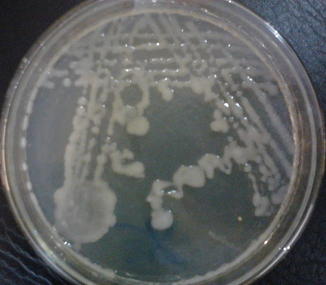Culturing technique is used for the propagation of microorganisms in the microbiology laboratory; and it is an important procedure required for studying the morphological characteristics of microbes especially on solid culture media. Microorganisms are cultured in various ways and in various conditions using different growth media (inclusive of solid media or broth/liquid media).
Bacterial growth on solid culture media is often the best approach for studying the physical appearance of a microbe in terms of its consistency, shape, texture, size and colour amongst other colonial features of microbes on solid growth medium. Culturing technique involves the inoculation of growth media with the inoculum (e.g. bacteria or fungi) or test sample suspected to contain a particular microbe.
The incubation of the culture plate under optimum condition that encourage the growth of the test organism. The cultured organism can appear in any of these forms on the solid culture media: as individual or discrete colonies and as confluent growth (i.e. film of surface growth).
Confluent growth is often required for performing antimicrobial susceptibility testing in the microbiology laboratory. In broth or liquid medium, bacterial growth is usually inferred by the presence of turbidity or cloudiness in the medium; and a loopful of the organism can be transferred onto a solid culture media to obtain pure cultures.
Various culturing techniques are used for the propagation of microorganisms in the microbiology laboratory. Examples of some notable culturing procedure include stab culture (produced by deep inoculation of solid medium in a tube with a straight wire loop), slope or slant culture (produced on the gradient of a solid medium in tubes) and plate culture (Figure 1) amongst others.

Figure 1. A nutrient agar culture plate. The organism is a clinical isolate of Klebsiella pneumoniae.
Note: Stab cultures are often used for biochemical tests and mycological investigations in which fungi or fungal samples are stabbed deep into solid media in tubes.
REFERENCES
Atlas R.M (2010). Handbook of Microbiological Media. Fourth edition. American Society of Microbiology Press, USA.
Balows A, Hausler W, Herrmann K.L, Isenberg H.D and Shadomy H.J (1991). Manual of clinical microbiology. 5th ed. American Society of Microbiology Press, USA.
Basic laboratory procedures in clinical bacteriology. World Health Organization (WHO), 1991. Available from WHO publications, 1211 Geneva, 27-Switzerland.
Black, J.G. (2008). Microbiology: Principles and Explorations (7th ed.). Hoboken, NJ: J. Wiley & Sons.
Garcia L.S (2010). Clinical Microbiology Procedures Handbook. Third edition. American Society of Microbiology Press, USA.
Garcia L.S (2014). Clinical Laboratory Management. First edition. American Society of Microbiology Press, USA.
Ira R (1995). Bacteriology, Standard Operative procedure manual for microbiology laboratories, National Institute of Biologicals. Pp. 73-97.
Madigan M.T., Martinko J.M., Dunlap P.V and Clark D.P (2009). Brock Biology of Microorganisms, 12th edition. Pearson Benjamin Cummings Inc, USA.
Woods GL and Washington JA (1995). The Clinician and the Microbiology Laboratory. Mandell GL, Bennett JE, Dolin R (eds): Principles and Practice of Infectious Diseases. 4th ed. Churchill Livingstone, New York.
Discover more from Microbiology Class
Subscribe to get the latest posts sent to your email.




